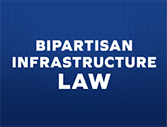Fact Sheet: Urbanized Area Formula Grants Program

BIPARTISAN INFRASTRUCTURE LAW FACT SHEET
URBANIZED AREA FORMULA PROGRAM GRANTS
| Fiscal Year | 2022 (in millions) |
2023 (in millions) |
2024 (in millions) |
2025 (in millions) |
2026 (in millions) |
|---|---|---|---|---|---|
| Urbanized Area Formula Program |
$6,330 | $6,463 | $6,633 | $6,770 | $6,943 |
| Passenger Ferry Grant Program |
$30 | $30 | $30 | $30 | $30 |
| Growing States Formula (5340) * |
$281 | $287 | $294 | $300 | $308 |
| High-Density States Formula (5340) * |
$348 | $356 | $365 | $372 | $382 |
Program Purpose:
The Bipartisan Infrastructure Law, enacted as the Infrastructure Investment and Jobs Act, continues, without change, the Urbanized Area Formula Funding program that makes federal resources available to urbanized areas and governors for transit capital and operating assistance in urbanized areas and for transportation-related planning. An urbanized area is an incorporated area with a population of 50,000 or more that is designated as such by the U.S. Department of Commerce, Bureau of the Census.
Statutory References:
49 U.S.C. § 5307, § 5340
Eligible Recipients:
Funding is made available to designated recipients that must be public bodies with the legal authority to receive and dispense federal funds. Governors, responsible local officials, and publicly owned operators of transit services are required to designate a recipient to apply for, receive, and dispense funds for urbanized areas pursuant to 49 U.S.C. 5307. The governor or governor’s designee is the designated recipient for urbanized areas between 50,000 and 200,000.
Eligible Activities:
The Bipartisan Infrastructure Law continues without change the broad range of activities eligible under the Urbanized Area Formula Program, including:
- Capital projects
- Planning
- Job access and reverse commute projects
- Operating costs of equipment and facilities for use in public transportation (in urbanized areas with a population of fewer than 200,000 individuals)
Eligible activities include planning, engineering design and evaluation of transit projects and other technical transportation-related studies; capital investments in bus and bus-related activities such as replacement of buses and overhaul and rebuilding of buses; crime prevention and security equipment; construction of maintenance and passenger facilities; and capital investments in new and existing fixed guideway systems, including rolling stock, overhaul, and rebuilding of vehicles, track, signals, communications, and computer hardware and software. All preventive maintenance and some Americans with Disabilities Act complementary paratransit service costs are considered capital costs.
For urbanized areas with populations less than 200,000, costs to operate equipment and facilities for use in public transportation is an eligible expense. In areas with a population greater than or equal to 200,000, operating assistance is an eligible expense for agencies that operate 100 or fewer vehicles in peak service, subject to published limits on expenditures for such expenses.
For urbanized areas with populations of 200,000 or greater, funds are apportioned and flow directly to a designated recipient selected locally to apply for and receive federal funds. For urbanized areas under 200,000 in population, the funds are apportioned to the governor of each state for distribution.
What’s Changed?
The Bipartisan Infrastructure Law requires recipients of Urbanized Area Formula Program (Section 5307) funds that serve urbanized areas with populations of 200,000 or more to allocate not less than 0.75 percent of their Urbanized Area Formula Program funds to safety related projects.
